Genus Hyllus
The genus Hyllus C. L. Koch, 1846 contains more than 50 species in Africa and several ones in other continents.
Distinguishing members of Hyllus and Evarcha is problematic. Many species in both genera have “horns” formed by tufts of long bristles located at posterior median eyes. Hyllus includes medium-sized to large spiders with rounded carapace, clearly wider than eye field, whereas members of Evarcha are usually smaller and their carapace is not as wide. Male pedipalp in Hyllus has generally long embolus, often with accompanying pars pendula, whereas the majority of Evarcha species have short embolus, sometimes with compound terminal apophysis epigyne in Evarcha has two pockets near epigastric furrow, which are not present in Hyllus, additionally the epigyne in the latter genus is more sclerotized.
Links: Wanda WesołoWska: Taxonomic notes on the genus Hyllus C. L. KoCh, 1846 in Africa (Araneae: Salticidae)
AW Arachnid Book: Spiders (Araneae) - Photos & Descriptions
Moderator: Klipspringer
AW Arachnid Book: Spiders (Araneae) - Photos & Descriptions
Jumping Spider Hyllus sp. possibly Hyllus brevitarsis
Family Salticidae

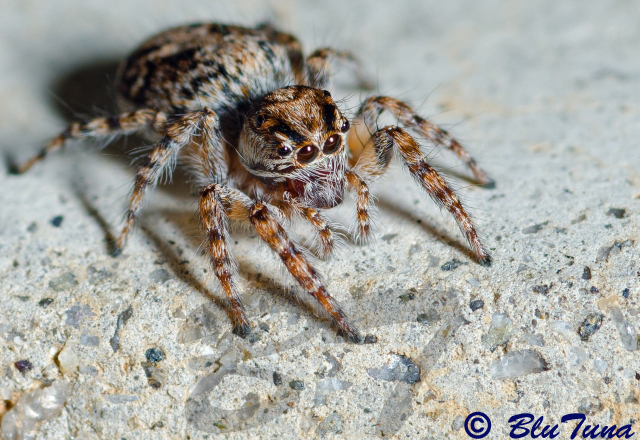
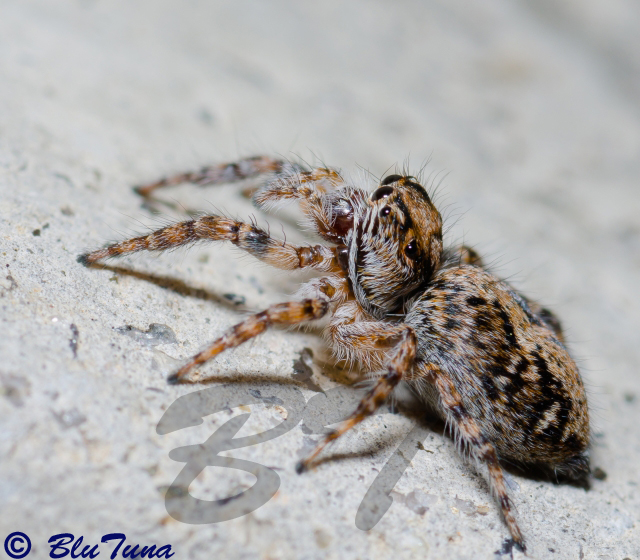
Garden in Johannesburg
Description of Hyllus brevitarsis
Male: Carapace rounded, high in cephalic part. Coloration of carapace brown, eyes with black rings, near eyes a few long brown bristles, in some specimens “horns” in vicinity of posterior median eyes composed of long bristles. Fovea visible, radiating dark lines from fovea on thoracic part of carapace. Carapace covered with short light hairs, denser hairs on clypeus. Below anterior lateral eyes three parallel strips. Chelicerae brown, their dorsal surfaces with whitish hairs. Gnathocoxae brown with light inner margins, sternum light brown. Abdomen elongated, narrowing posteriorly. Dorsum of abdomen covered with delicate, dark brown, shiny scutum, anterior edge lighter, apodemes well visible. Some thin hairs on abdomen. Venter yellowish grey with darker longitudinal strip. Spinnerets long, brown. Legs long, brown, clothed in long, dense, light and dark hairs. Very long and dense hairs on patellae, tibiae and metatarsi I and II ventrally. Spines long, brown. Pedipalps brown, hairy, some translucent scales on cymbium and tibia.
Female: Bigger than male. Carapace brown, slightly lighter on thoracic part, “horns” present. Clypeus low, with white hairs. Mouth parts brown, with lighter tips. Sternum
brown, with darker margins. Abdomen brownish orange with blackish pattern- Abdominal hairs dense, some hairs - especially sparse white ones - very long. Venter yellow, tinged with grey, darker strip medially. Spinnerets dark. Legs reddish brown, femora and distal ends of other segments darker. Leg hairs long, dark. Spines numerous, brown. Pedipalps light brown.
Distribution of Hyllus brevitarsis
Widespread in Afrotropical region. Known distribution: Botswana, Ethiopia, Ivory Coast, Mozambique, Namibia, Somalia, South Africa, Tanzania, Zimbabwe.
Links: Wanda WesołoWska: Taxonomic notes on the genus Hyllus
Family Salticidae



Garden in Johannesburg
Description of Hyllus brevitarsis
Male: Carapace rounded, high in cephalic part. Coloration of carapace brown, eyes with black rings, near eyes a few long brown bristles, in some specimens “horns” in vicinity of posterior median eyes composed of long bristles. Fovea visible, radiating dark lines from fovea on thoracic part of carapace. Carapace covered with short light hairs, denser hairs on clypeus. Below anterior lateral eyes three parallel strips. Chelicerae brown, their dorsal surfaces with whitish hairs. Gnathocoxae brown with light inner margins, sternum light brown. Abdomen elongated, narrowing posteriorly. Dorsum of abdomen covered with delicate, dark brown, shiny scutum, anterior edge lighter, apodemes well visible. Some thin hairs on abdomen. Venter yellowish grey with darker longitudinal strip. Spinnerets long, brown. Legs long, brown, clothed in long, dense, light and dark hairs. Very long and dense hairs on patellae, tibiae and metatarsi I and II ventrally. Spines long, brown. Pedipalps brown, hairy, some translucent scales on cymbium and tibia.
Female: Bigger than male. Carapace brown, slightly lighter on thoracic part, “horns” present. Clypeus low, with white hairs. Mouth parts brown, with lighter tips. Sternum
brown, with darker margins. Abdomen brownish orange with blackish pattern- Abdominal hairs dense, some hairs - especially sparse white ones - very long. Venter yellow, tinged with grey, darker strip medially. Spinnerets dark. Legs reddish brown, femora and distal ends of other segments darker. Leg hairs long, dark. Spines numerous, brown. Pedipalps light brown.
Distribution of Hyllus brevitarsis
Widespread in Afrotropical region. Known distribution: Botswana, Ethiopia, Ivory Coast, Mozambique, Namibia, Somalia, South Africa, Tanzania, Zimbabwe.
Links: Wanda WesołoWska: Taxonomic notes on the genus Hyllus
Hunting cannot be considered a sport as all contestants in a sport should know they are playing the game!
Salticidae, Genus Myrmarachne
Genus Myrmarachne
Myrmarachne is a genus of jumping spiders which imitate an ant by waving their front legs in the air to simulate antennae. Some species also look strikingly like ants. Spiders in this genus are commonly called antmimicking spiders, although there are many other spiders that mimic ants. Their resemblance to ants appear to function primarily as Batesian mimicry. Many predators avoid eating ants, so their resemblance to these insects protects them from predators.
The cephalothorax is elongated, with long chelicerae projecting forward in males. A waist is present on the cephalothorax, and often also on the opisthosoma. Colors vary from black to yellow, depending on the mimicked ant species. One African species was observed to mimick one species when immature, and another as an adult.
Several species (17 or more) are recorded from South Africa:
Myrmarachne albosetosa
Myrmarachne dundoensis
Myrmarachne foenisex
Myrmarachne foreli
Myrmarachne ichneumon
Myrmarachne inflatipalpis
Myrmarachne laurentina
Myrmarachne leleupi
Myrmarachne lesserti
Myrmarachne lulengana
Myrmarachne marshalli
Myrmarachne natalica
Myrmarachne solitaria
Myrmarachne uvira
Myrmarachne is a genus of jumping spiders which imitate an ant by waving their front legs in the air to simulate antennae. Some species also look strikingly like ants. Spiders in this genus are commonly called antmimicking spiders, although there are many other spiders that mimic ants. Their resemblance to ants appear to function primarily as Batesian mimicry. Many predators avoid eating ants, so their resemblance to these insects protects them from predators.
The cephalothorax is elongated, with long chelicerae projecting forward in males. A waist is present on the cephalothorax, and often also on the opisthosoma. Colors vary from black to yellow, depending on the mimicked ant species. One African species was observed to mimick one species when immature, and another as an adult.
Several species (17 or more) are recorded from South Africa:
Myrmarachne albosetosa
Myrmarachne dundoensis
Myrmarachne foenisex
Myrmarachne foreli
Myrmarachne ichneumon
Myrmarachne inflatipalpis
Myrmarachne laurentina
Myrmarachne leleupi
Myrmarachne lesserti
Myrmarachne lulengana
Myrmarachne marshalli
Myrmarachne natalica
Myrmarachne solitaria
Myrmarachne uvira
AW Arachnid Book: Spiders (Araneae) - Photos & Descriptions
Ant-mimicking Jumping Spider Myrmarachne natalica
Family Salticidae
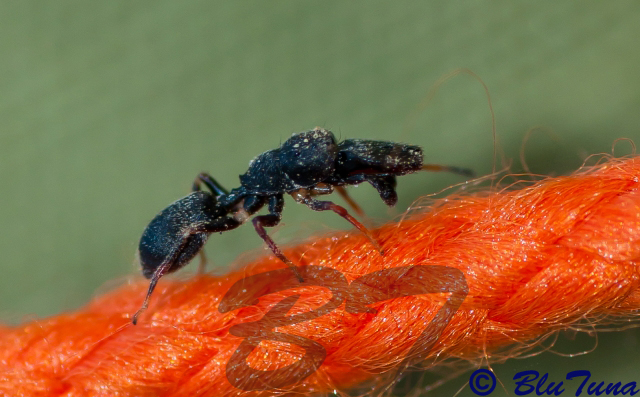
Kruger National Park
Description
M. natalica is a distinctive species easily recognized by the unusually long thorax. Body is ant-like with elongated mandibles. Abdomen mottled brownish black, a very scanty white haired band in constricted region. Legs long and slender, black and light brown-orange.
Family Salticidae

Kruger National Park
Description
M. natalica is a distinctive species easily recognized by the unusually long thorax. Body is ant-like with elongated mandibles. Abdomen mottled brownish black, a very scanty white haired band in constricted region. Legs long and slender, black and light brown-orange.
Hunting cannot be considered a sport as all contestants in a sport should know they are playing the game!
Salticidae, Genus Nigorella
Genus Nigorella
The genus Nigorella is a small Afrotropical genus, only containing four poorly known species. Nigorella hirsuta is recorded from Zimbabwe and South Africa.
Nigorella manica occurs in Zimbabwe.
These spiders are medium to large in size, with dark colouration; the males have a characteristic embolus enveloped by a terminal apophysis; the gonopores in the female’s epigyne are hidden in strongly sclerotized “cups”.
Links: Survey of the genus Nigorella
The genus Nigorella is a small Afrotropical genus, only containing four poorly known species. Nigorella hirsuta is recorded from Zimbabwe and South Africa.
Nigorella manica occurs in Zimbabwe.
These spiders are medium to large in size, with dark colouration; the males have a characteristic embolus enveloped by a terminal apophysis; the gonopores in the female’s epigyne are hidden in strongly sclerotized “cups”.
Links: Survey of the genus Nigorella
AW Arachnid Book: Spiders (Araneae) - Photos & Descriptions
Jumping Spider Nigorella hirsuta
Family Salticidae
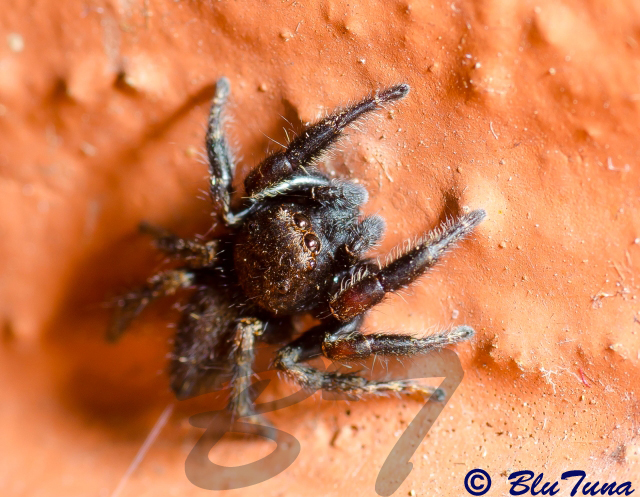
Male
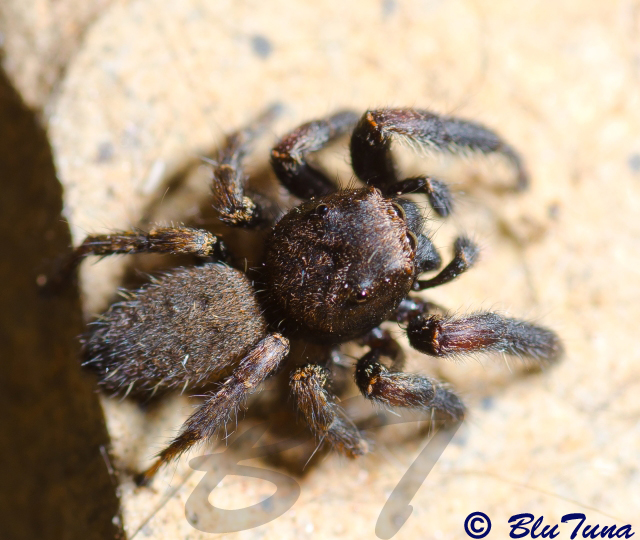
Garden in Johannesburg
Distribution
Recorded from South Africa and Zimbabwe. Very widespread in central and eastern South Africa.
Habitat
A ground-dwelling species. Common in grassland, often found at the base of grass tussocks.
Family Salticidae

Male

Garden in Johannesburg
Distribution
Recorded from South Africa and Zimbabwe. Very widespread in central and eastern South Africa.
Habitat
A ground-dwelling species. Common in grassland, often found at the base of grass tussocks.
Hunting cannot be considered a sport as all contestants in a sport should know they are playing the game!
Salticidae, Genus Thyene
Genus Thyene
This genus Thyene includes over 40 species, the majority of them being distributed in the Afrotropical Region.
Members of Thyene are characterized by the presence of tufts of long black hairs near the posterior median eyes. The genital organs are very similar; the male palp has a rounded bulb and embolus encircling it few times; the epigyne is very weakly sclerotized, with a central window, seminal ducts forming a few loops, and very long accessory glands. Thyene species may be more easily distinguished by their colouration than by genitalic structures.
Links: Charles R. Haddad and Wanda Wesołowska: New species and new records of jumping spiders (Araneae: Salticidae) from central South Africa; Jumping Spiders
This genus Thyene includes over 40 species, the majority of them being distributed in the Afrotropical Region.
Members of Thyene are characterized by the presence of tufts of long black hairs near the posterior median eyes. The genital organs are very similar; the male palp has a rounded bulb and embolus encircling it few times; the epigyne is very weakly sclerotized, with a central window, seminal ducts forming a few loops, and very long accessory glands. Thyene species may be more easily distinguished by their colouration than by genitalic structures.
Links: Charles R. Haddad and Wanda Wesołowska: New species and new records of jumping spiders (Araneae: Salticidae) from central South Africa; Jumping Spiders
Re: AW Arachnid Book: Spiders (Araneae) - Photos & Descripti
Jumping Spider Thyene inflata
Family Salticidae
 © BluTuna
© BluTuna
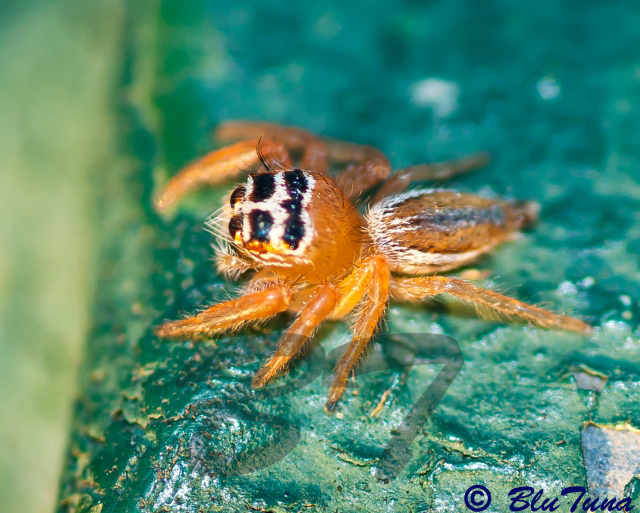 © BluTuna
© BluTuna
Male, Kruger National Park
Description
Female Thyene inflata have a yellowish carapace. Males have a reddish carapace with dark spots.
Oval abdomen with dark central stripe bordered by red and yellow-white lines.
Distribution
A widespread Afrotropical species.
Habitat
Often on foliage of shrubs in savannah and riverine habitats.
Links:
Jumping spiders (Araneae: Salticidae) of the Ndumo Game Reserve, Maputaland, South Africa; Salticidae: Diagnostic Drawings Library[/quote]
Family Salticidae
 © BluTuna
© BluTuna © BluTuna
© BluTunaMale, Kruger National Park
Description
Female Thyene inflata have a yellowish carapace. Males have a reddish carapace with dark spots.
Oval abdomen with dark central stripe bordered by red and yellow-white lines.
Distribution
A widespread Afrotropical species.
Habitat
Often on foliage of shrubs in savannah and riverine habitats.
Links:
Jumping spiders (Araneae: Salticidae) of the Ndumo Game Reserve, Maputaland, South Africa; Salticidae: Diagnostic Drawings Library[/quote]
Hunting cannot be considered a sport as all contestants in a sport should know they are playing the game!
AW Arachnid Book: Spiders (Araneae) - Photos & Descriptions
Jumping Spider Thyene natalii
Family: Salticidae.
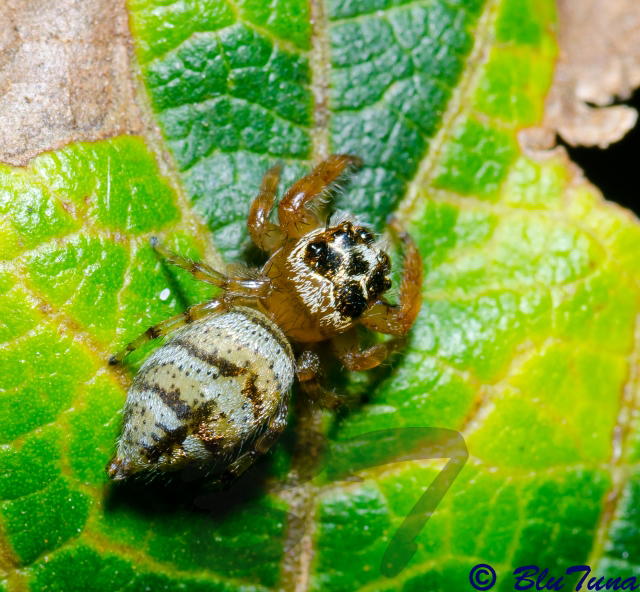
Garden in Johannesburg.

Garden in Johannesburg.
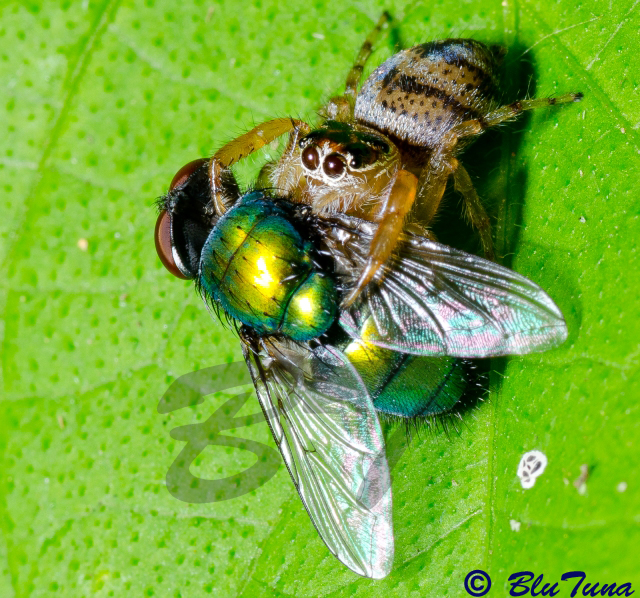
With Banded Blow Fly prey. Garden in Johannesburg.

With Banded Blow Fly prey. Garden in Johannesburg.
Distribution
Widespread in southern and eastern Africa. In South Africa it iscommon in KwaZulu-Natal.
Habitat
This species is often found on foliage in savannah habitats in KwaZulu-Natal.
Links: Peckham Society
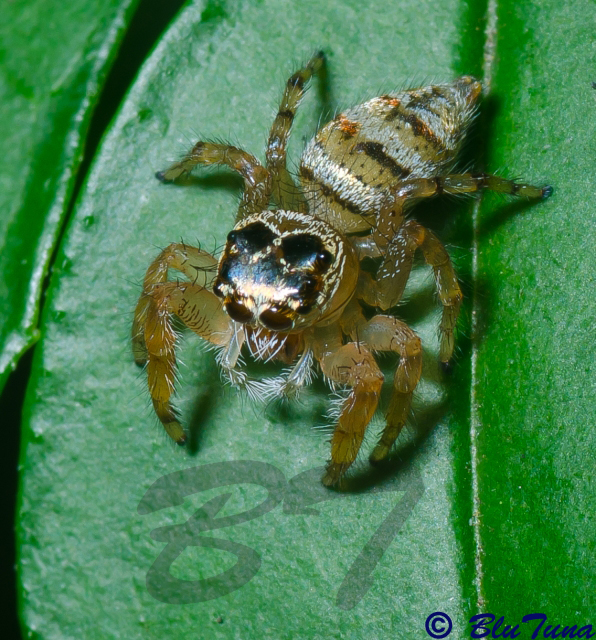
Garden in Johannesburg
Family: Salticidae.

Garden in Johannesburg.

Garden in Johannesburg.

With Banded Blow Fly prey. Garden in Johannesburg.

With Banded Blow Fly prey. Garden in Johannesburg.
Distribution
Widespread in southern and eastern Africa. In South Africa it iscommon in KwaZulu-Natal.
Habitat
This species is often found on foliage in savannah habitats in KwaZulu-Natal.
Links: Peckham Society

Garden in Johannesburg
Hunting cannot be considered a sport as all contestants in a sport should know they are playing the game!
AW Arachnid Book: Spiders (Araneae) - Photos & Descriptions
Jumping Spider Thyene ogdeni
Family Salticidae
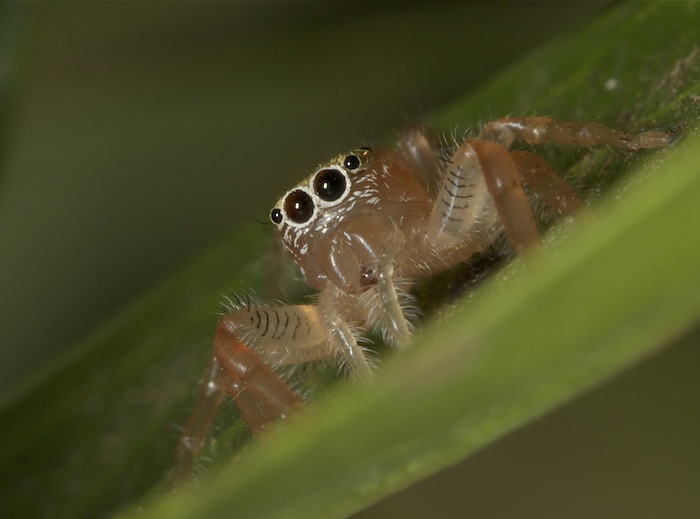 © ExFmem
© ExFmem
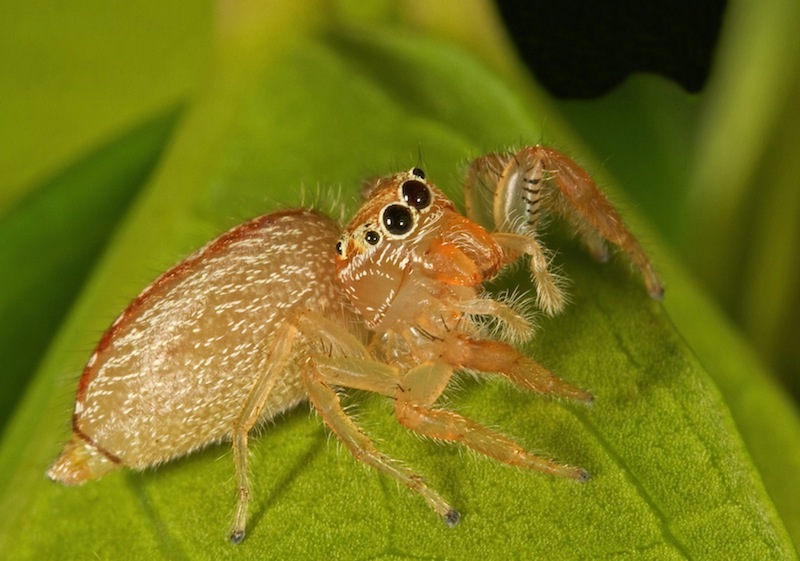 © ExFmem
© ExFmem
Oct. 2012 Kruger National Park
Description
Male:
Carapace oval, widest behind midpoint, light brown, darker at margins; eyes surrounded by black rings, some long brown bristles near anterior eyes; white scale-like hairs form transverse band on ocular area, behind anterior eyes and two streaks laterally from eye field; scattered white hairs on middle of thoracic part of carapace. Chelicerae and clypeus dark brown, labium and endites light brown with wide white tips; sternum whitish yellow. Abdomen elongate, narrow, yellowish medially, brownish laterally, with five pairs of black patches, between them small white spots; brown hairs sparsely cover dorsum of abdomen; venter whitish with silver patches of translucent guanine crystals; spinnerets light. First pair of legs larger than others, tibia with three retrolateral and four prolateral spines ventrally, metatarsus with two pairs of spines ventrally; legs generally light brown; ventral and prolateral surface of first femur decorated with black transverse stripes; coxae, trochanters and basal part of femora whitish; femora II-IV tinged with grey. Pedipalps dark yellow, white scales on palpal femur; tibia short, its apophysis armed with two very small teeth; at base of the apophysis few short sharp bristles; cymbium with row of thick sharp setae on retrolateral edge; tegulum rounded with small protuberance near base of embolus; embolus long, encircling tegulum three times.
Female:
Similar to male but lighter coloured. Abdomen with wide yellow streak medially, with two brown lines lateral of the streak, cut in posterior part by small white patches; sides orange brownish. Legs yellow, first femur with transverse bands formed by dark spots. Epigyne typical for Thyene, very weakly sclerotised, rounded with shallow depression. Seminal ducts form a few loops, receptacles multi-chambered, complex.
Distribution
Species known only from South Africa.
Habitat
Foliage of shrubs and short trees.
Kruger National Park, Pafuri © Richprins
Links:
Jumping spiders (Araneae: Salticidae) of the Ndumo Game Reserve, Maputaland, South Africa
Family Salticidae
 © ExFmem
© ExFmem © ExFmem
© ExFmemOct. 2012 Kruger National Park
Description
Male:
Carapace oval, widest behind midpoint, light brown, darker at margins; eyes surrounded by black rings, some long brown bristles near anterior eyes; white scale-like hairs form transverse band on ocular area, behind anterior eyes and two streaks laterally from eye field; scattered white hairs on middle of thoracic part of carapace. Chelicerae and clypeus dark brown, labium and endites light brown with wide white tips; sternum whitish yellow. Abdomen elongate, narrow, yellowish medially, brownish laterally, with five pairs of black patches, between them small white spots; brown hairs sparsely cover dorsum of abdomen; venter whitish with silver patches of translucent guanine crystals; spinnerets light. First pair of legs larger than others, tibia with three retrolateral and four prolateral spines ventrally, metatarsus with two pairs of spines ventrally; legs generally light brown; ventral and prolateral surface of first femur decorated with black transverse stripes; coxae, trochanters and basal part of femora whitish; femora II-IV tinged with grey. Pedipalps dark yellow, white scales on palpal femur; tibia short, its apophysis armed with two very small teeth; at base of the apophysis few short sharp bristles; cymbium with row of thick sharp setae on retrolateral edge; tegulum rounded with small protuberance near base of embolus; embolus long, encircling tegulum three times.
Female:
Similar to male but lighter coloured. Abdomen with wide yellow streak medially, with two brown lines lateral of the streak, cut in posterior part by small white patches; sides orange brownish. Legs yellow, first femur with transverse bands formed by dark spots. Epigyne typical for Thyene, very weakly sclerotised, rounded with shallow depression. Seminal ducts form a few loops, receptacles multi-chambered, complex.
Distribution
Species known only from South Africa.
Habitat
Foliage of shrubs and short trees.
Kruger National Park, Pafuri © Richprins
Links:
Jumping spiders (Araneae: Salticidae) of the Ndumo Game Reserve, Maputaland, South Africa


